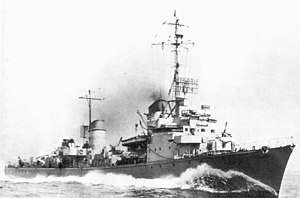German torpedo boat T34
 Sister ship T35 in US service, August 1945
| |
| History | |
|---|---|
| Name | T34 |
| Ordered | 20 January 1941 |
| Builder | Elbing, East Prussia |
| Yard number | 1516 |
| Laid down | 5 March 1943 |
| Launched | 23 October 1943 |
| Completed | 12 August 1944 |
| Fate | Sunk by mine, 20 November 1944 |
| General characteristics (as built) | |
| Class and type | Type 39 torpedo boat |
| Displacement | |
| Length | 102.5 m (336 ft 3 in) o/a |
| Beam | 10 m (32 ft 10 in) |
| Draft | 3.22 m (10 ft 7 in) |
| Installed power |
|
| Propulsion |
|
| Speed | 33.5 knots (62.0 km/h; 38.6 mph) |
| Range | 2,400 nmi (4,400 km; 2,800 mi) at 19 knots (35 km/h; 22 mph) |
| Complement | 206 |
| Sensors and processing systems |
|
| Armament |
|
The German torpedo boat T34 was one of fifteen
in November and sank.Design and description
The Type 39 torpedo boat was conceived as a general-purpose design, much larger than preceding German torpedo boats.kW) which was intended give the ships a maximum speed of 33.5 knots (62.0 km/h; 38.6 mph). They carried enough fuel oil to give them a range of 2,400 nautical miles (4,400 km; 2,800 mi) at 19 knots (35 km/h; 22 mph).[4]
As built, the Type 39 ships mounted four
amidships and could also carry 30 mines; the full complement of 60 mines made the ships top-heavy which could be dangerous in bad weather. For anti-submarine work the boats were fitted with a S-Gerät sonar and four depth charge launchers. The Type 39s were equipped with a FuMO 21 radar[Note 1] and various FumB[Note 2] radar detectors were installed late in the war.[5]
Construction and career
T34 was ordered on 20 January 1941 from
yard number 1516, launched on 23 October 1943 and commissioned on 12 August 1944. Kapitänleutnant Freiherr von Lüttitz was appointed in command. As part of her lengthy working up, she conducted gunnery practice with the radio-controlled target ship Hessen in the Baltic on 20 November, the boat struck a mine laid by Soviet submarine L-3 and sank off Cape Arkona at 54°40′N 13°29′E / 54.667°N 13.483°E with the loss of 62 crewmen.[6]
Notes
Citations
References
- ISBN 0-85177-238-2.
- ISBN 0-87021-790-9.
- ISBN 1-59114-119-2.
- Sieche, Erwin (1980). "Germany". In Chesneau, Roger (ed.). Conway's All the World's Fighting Ships 1922–1946. London: Conway Maritime Press. ISBN 0-85177-146-7.
- ISBN 1-85409-521-8.
- Whitley, M. J. (1991). German Destroyers of World War Two. Annapolis, Maryland: Naval Institute Press. ISBN 1-55750-302-8.
